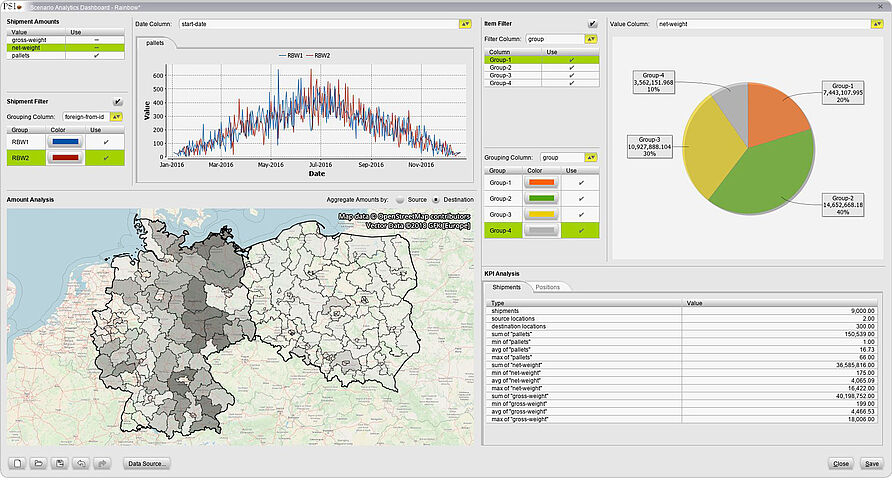Supply Chain Network Design (SCND) is becoming increasingly important as a result of recent crises such as the coronavirus pandemic, extreme weather events, and geopolitical conflicts. Companies face the challenge of designing their supply chains to meet both economic and environmental requirements. How can they achieve these goals through strategic network planning, and what role do software systems play?
Relevance and advantages of supply chain network design
Continuous analysis of potential risks in the supply chain is crucial to identify weaknesses and take appropriate risk mitigation measures. Measures must be developed in advance for the identified risks in order to reduce the risk of occurrence or to minimize the consequences if they do occur. This requires openness to new solutions and a willingness to question existing processes and structures.
Supply chain network design is relevant for all companies that want to supply their production sites and customers reliably. It is particularly important for companies with larger and more complex networks. These include, for example, international companies with several production, storage and distribution sites, companies with a large number of suppliers and customers and changing relationships, and industries that are strongly affected by changing market conditions and short-term fluctuations.
The increasing size and complexity of supply chains make it almost impossible to plan and optimize those using conventional means such as Excel spreadsheets. The reasons for this include multiple network levels, multiple locations at each level (production, central warehouse, and regional warehouse), a large number of suppliers and customers with changing relationships, and the diversity and accumulation of risks. However, the inability to control these processes using Excel is mainly due to the enormous volume of data that has to be processed in such networks.
What is Supply Chain Network Design (SCND)?
Supply chain network design is the process of optimizing the physical configurations and operations of a supply chain system. It involves the strategic planning and arrangement of suppliers, production sites, warehouses, and distribution centers, as well as the optimization of transport routes between these locations. The goal is to minimize costs and maximize service quality while reducing the risks posed by unexpected disruptions in the supply chain.
The crises of recent years have put the stability of supply chains to the test and shown the importance of robust supply chain management (SCM). While before the coronavirus pandemic, supply chains were primarily designed according to the principle of cost-effectiveness, the focus has now broadened. Factors such as cost, quality and time remain central, but the resilience and sustainability of the supply chain have also become key drivers in the design.
Functions and benefits of SCND software
A supply chain network design software solution such as PSIglobal helps companies analyze existing data and logistics structures. Based on this, scenarios can be developed and compared with each other in order to achieve an optimal balance of target values such as costs, efficiency, service levels, resilience, and sustainability in the logistics network. Another key advantage is the ability to process complex data and provide actionable insights.
The software requires basic information such as location and shipment data, maximum capacities of the locations and the costs of current operations. With this data, PSIglobal allows users to model scenarios that help companies achieve optimal structures and processes.

One example: by performing a detailed analysis of location and shipment data, as well as the maximum capacities of logistics locations, PSIglobal identifies potential for rearranging locations and optimizing transport routes. Users can add, remove or restructure locations within the software to shorten transport routes and increase overall efficiency. At the same time, the software helps to plan optimal routes to maximize vehicle utilization and minimize emissions. This results in better resource utilization and lower operating costs.
In many projects, the importance of data quality is underestimated. However, high-quality data is essential to ensure precise analyses and well-informed decisions.
Data quality plays a crucial role in the analysis. Companies should therefore ensure that their data is comprehensive, accurate and up to date. The software enables companies to efficiently process and analyze these extensive data volumes. By consolidating the data from the various source systems, PSIglobal thus acts as a single source of truth.
Future prospects with PSIglobal
With strategic network planning using PSIglobal, companies can effectively respond to the complex challenges of modern markets. The comprehensive analysis and optimization of locations and transport routes not only reduces costs and improves service times, but also increases sustainability and resilience. In an age where economic and ecological benefits must go hand in hand, PSIglobal offers a future-oriented solution that helps companies achieve their goals while also making a positive contribution to environmental protection.



